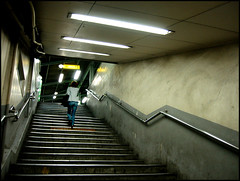Toggle ON/OFF
Moving from one place to another.
 photo-hyperspace328
photo-hyperspace328
Mobile communication technologies create increasingly hybrid forms of presence where rather than being transported to another shared space the person remains aware of their presence in the immediate space whilst communicating in a hybrid media space. This is significantly different from the effortful and temporal nature of transition in physical space; walking through a door, climbing a staircase and crossing a bridge. All of these movements between one space and another require the person to physically move in order to be somewhere else and as they undertake this movement to experience a period ‘between’ one space and the other. In the use of media in urban public space the individual merely switches their sensory and mental attention between the media device or screen and the features of the real world. In this way the person toggles their involvement from the physical space to media space like an on/off type effect. This has an impact inn how people move in the space since rather than simply moving faster or slower the rhythm of motion starts and stops, as the person’s interaction with media switches between attention to the media and attention to the physical environment. The person may choose when to switch, such as deciding to make a phone call or send a message and seek out a suitable space in the environment to do this. Often this means moving to a place out of the dynamic flow of pedestrian traffic; a corner or niche to stand in or a bench to sit. But the media use may be asynchronous with the space, such as when someone receives an SMS message or an LBS alert about a location. The switching is then asynchronous with the rhythm of the space they are in; it adds a secondary, non-spatially defined temporality to the space which is often at odds with the rhythms in the physical place. Thus phenomena are observed where people literally bump into things or people, where they suddenly stop in the pedestrian flow of a crowd. As users start to interact more with screen based media, as opposed to more auditory media such as mobile phone calls, this effect will be enhanced since not only their auditory attention but their visual attention will be switched to the media and not the characteristics of the physical space they are present in.
 photo-hyperspace328
photo-hyperspace328Mobile communication technologies create increasingly hybrid forms of presence where rather than being transported to another shared space the person remains aware of their presence in the immediate space whilst communicating in a hybrid media space. This is significantly different from the effortful and temporal nature of transition in physical space; walking through a door, climbing a staircase and crossing a bridge. All of these movements between one space and another require the person to physically move in order to be somewhere else and as they undertake this movement to experience a period ‘between’ one space and the other. In the use of media in urban public space the individual merely switches their sensory and mental attention between the media device or screen and the features of the real world. In this way the person toggles their involvement from the physical space to media space like an on/off type effect. This has an impact inn how people move in the space since rather than simply moving faster or slower the rhythm of motion starts and stops, as the person’s interaction with media switches between attention to the media and attention to the physical environment. The person may choose when to switch, such as deciding to make a phone call or send a message and seek out a suitable space in the environment to do this. Often this means moving to a place out of the dynamic flow of pedestrian traffic; a corner or niche to stand in or a bench to sit. But the media use may be asynchronous with the space, such as when someone receives an SMS message or an LBS alert about a location. The switching is then asynchronous with the rhythm of the space they are in; it adds a secondary, non-spatially defined temporality to the space which is often at odds with the rhythms in the physical place. Thus phenomena are observed where people literally bump into things or people, where they suddenly stop in the pedestrian flow of a crowd. As users start to interact more with screen based media, as opposed to more auditory media such as mobile phone calls, this effect will be enhanced since not only their auditory attention but their visual attention will be switched to the media and not the characteristics of the physical space they are present in.

